Menu
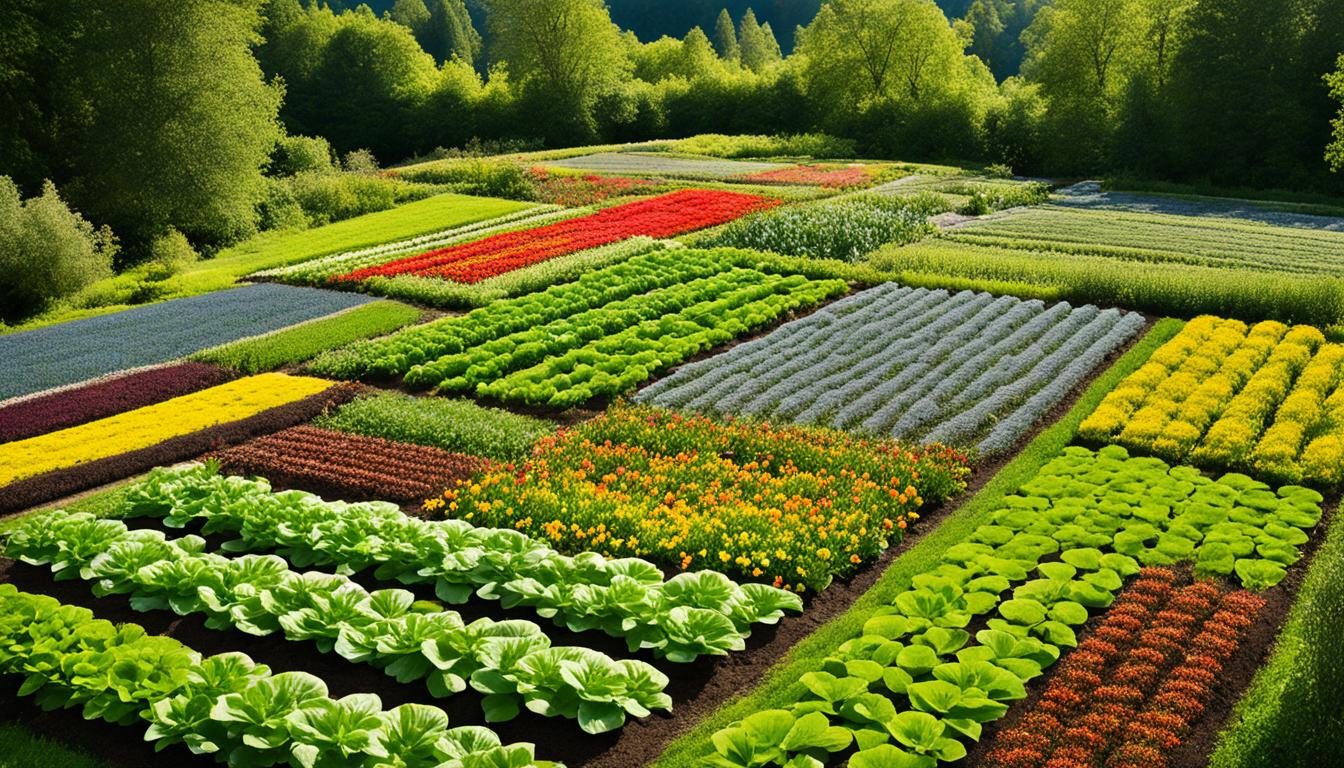
They say you must see something missing to understand its value. Once, I walked through a conventional farm. There was a strange silence. No insects buzzed. No birds sang. The soil, once full of life, lay tired. But walking onto an organic farm, things changed. Life flourished in every corner. It was like seeing a painting of nature’s beauty.
Organic farming does more than just grow good food. It helps the whole environment thrive. The EU Organic Action Plan says, organic farming brings 30% more biodiversity. In fields, it means 20-95% more types of plants and up to 150% more of them. These numbers show why we need to farm in ways that keep our world full of different plants and animals.
My journey into sustainable farming has shown me so much. Did you know, organic farming can have 23% more kinds of insects and 30% more pollinators? This makes a big difference, like other research says. It shows that farming in harmony with nature isn’t just an option. It’s a must for the health of our planet.
Organic farming is a way of farming that focuses on organic agriculture principles. It uses natural processes to grow food. This method keeps the land and water healthy. It also helps protect the variety of life on Earth.
Organic farming looks at the farm as a whole system. It aims to keep the soil rich and healthy. Farmers use things like compost and changing the crops they grow in each field. This way, they avoid using harmful chemicals but still grow plenty of food.
Organic farmers work with nature to create farms that are good for the environment. Their methods help keep the farm going for the long term without hurting the planet.
Biodiversity means having many different types of life living together. In farms, a lot of different plants and animals help make the farm stronger. They protect the farm against problems, like diseases. Studies show that organic farms in Europe have more diverse plants and more living things than other farms.
An important report tells us that grasslands and horticulture that are organic have more variety in plants and bugs. Even birds that eat insects are doing better on these farms.
The EU is helping these farms with money to encourage more organic farming. This way, about 8% of their land is now organic. This shows the EU’s commitment to supporting nature-friendly farming.
All EU countries, apart from the Netherlands, are working to support organic farming. They help farmers change their ways to be more organic. Organic farming helps by using different plants in the fields, which is good for the land. It also creates spaces that are good for many different living things.
| Region | Biodiversity Increase (%) | Abundance Increase (%) |
|---|---|---|
| Arable Organic Systems | 20-95 | Up to 150 |
| Grassland Organic Systems | More diverse plant species | Increased soil microbes |
Since the 1990s, organic farming has been praised for helping the environment. It is an important part of the organic movement today.
Organic farming helps nature thrive. It uses natural ways to grow crops. This means lots of different plants and animals can live together and help each other. This is very important for the land to stay healthy for farming in the long run.
Studies show that organic farms are great for both the soil and the insects that help plants grow (Mäder et al., 2002). They attract more bees and other pollinators than regular farms (Holzschuh et al., 2007). By not using harmful chemicals, pests have natural enemies that keep them in check without any harm to the environment
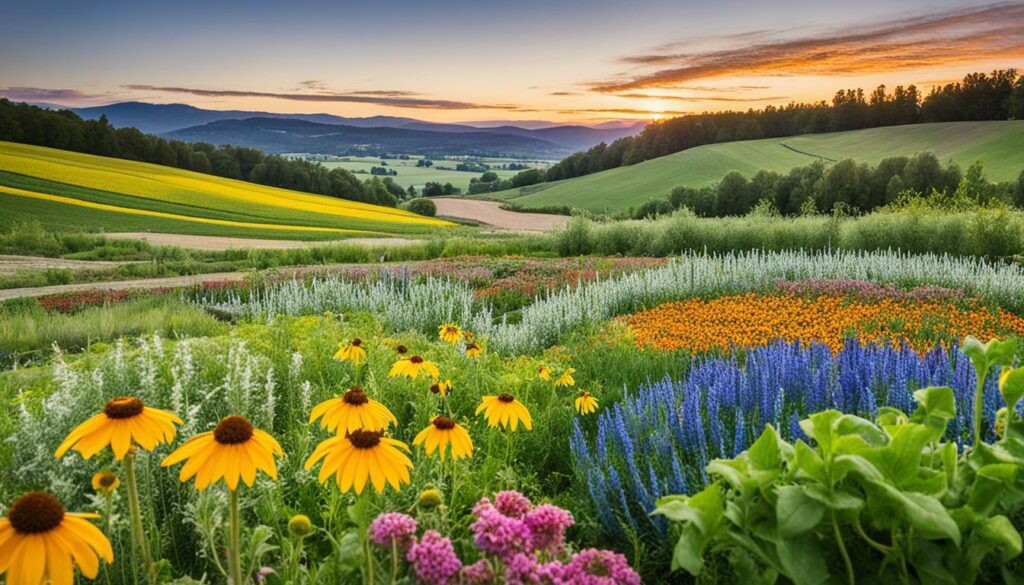
Organic farms are known to have more types of living things than usual farms. This is because they are kinder to the soil and allow more creatures to live there, like earthworms. Birds, butterflies, and helpful beetles also prefer such places because there are no toxic chemicals, and lots of different plants to choose from.
Choosing organic farming also means less harm to our health and the planet. Without chemicals, the soil is full of good bacteria and other tiny creatures that keep it healthy (Pimentel et al., 2005). Plants that grow by themselves in organic farms attract bugs that eat harmful pests, lessening the need for chemicals.
| Attributes | Organic Farming | Conventional Farming |
|---|---|---|
| Species Abundance | 30% more | Less abundant |
| Pollinator Diversity | Higher | Lower |
| Soil Microbes Growth | Higher | Reduced |
| Natural Pest Control | More effective | Less effective |
By taking care of the land in natural ways, organic farms are better for the future. This way of farming helps the earth and the farmers. Healthy fields and forests mean better food and a richer planet for us all.
Traditional farming largely drives down the number of different plants and animals that can live together. This happens through big changes in the natural environment. These changes are due to the use of only one type of crop in an area, as well as the heavy use of harmful pesticides and weed killers.
Monocultures do not support a wide range of plants or animals. They are farming of just one crop over a huge area. Such farming does not provide varied living space for creatures. This means there are fewer types of living things. It also makes crops an easy target for insects and diseases, which leads to more pesticide use.
Using pesticides is tied to losing biodiversity. Traditional farming uses a lot of man-made chemicals to control pests and weeds. These pesticides and weed killers harm other organisms that are not the target. These include insects that help plants grow, like bees, and tiny organisms in the soil. The use of these chemicals reduces the ability of natural systems to manage pests. It also speeds up the loss of helpful creatures.
| Farming Practice | Impact on Biodiversity | Study / Source |
|---|---|---|
| Monocultures | Reduces plant and insect diversity, increases pest and disease vulnerability, heightened by climatic adversities | Various Studies |
| Pesticide Use | Negatively impacts non-target species, reduces pollinator and beneficial insect populations | Various Studies |
Organic farming is growing fast, showing the importance of sustainable practices in boosting biodiversity. These methods help keep the ecological balance and bring many benefits to the farm. Two main practices stand out: crop rotation and planting native vegetation.
Crop rotation boosts soil health and the variety of crops. By growing different plants in the same area at different times, farmers improve the soil naturally. This method adds nutrients, makes the soil stronger, and boosts its food value. Studies show soils and living things in them do better under these organic methods (Mäder et al., 2002).
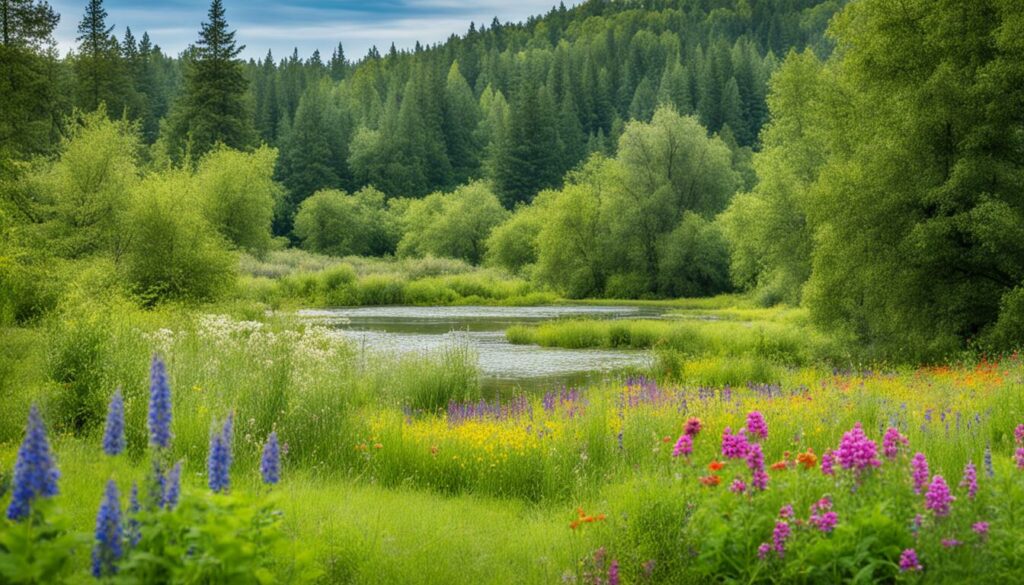
Planting native plants is key for saving local species. Organic farmers grow local plants to bring back native habitats and help useful bugs thrive. Research, like Gabriel et al.’s work in 2007, shows this helps bring more types of bees and other pollinators. The USDA’s National Organic Program agrees, saying this helps feed and shelter good bugs.
These farming ways really help nature thrive, creating a balanced and strong system.
Keeping soil healthy is key in organic farming to have diverse life. We’ll explore how using compost and cover crops helps. They make the soil full of different organisms. This is good for the land and the plants grown on it.
Composting adds important things to the soil, which improves it for farming. It brings in many nutrients as the materials break down. This helps create a place where many kinds of tiny creatures can live.
| Organism | Number of Species | Individual Organisms |
|---|---|---|
| Prokaryotes (bacteria) | 9000 | 200 trillion |
| All Fungi | 2001 | 2001 million |
| Mycorrhizal Fungi | – | 20,800,000 |
| Protists | 1,200 | 10 million |
| Nematodes | – | 1009 million |
| Enchytraeids | – | 15300,000 |
| Collembola (springtails) | – | 2050,000 |
| Mites (Oribatida) | – | 150100,000 |
| Isopoda (woodlouse) | 100 | 10 |
| Diplopoda (millipedes) | 2,500 | 100 |
| Earthworms (Oligochaeta) | 15 | 300 |
Composting also makes the ecosystem stronger and more productive. It’s all about variety in the life found in the soil.
Cover crops, like clover and ryegrass, make the soil more alive and fertile. They have deep roots that help the soil hold water. This is good for plants and for the small organisms that live near them.
These crops add a lot to the soil, which helps all kinds of life thrive. So, both composting and cover cropping are very helpful in organic farming. They make the soil better and full of life, which is great for the whole farming system.
Organic farming is better with natural pest control. It uses habitats to promote birds and bats. These predators lower the need for chemical pesticides. A joint study from Washington State University and the University of Georgia shows the benefits of organic farming. It builds farming areas that are good for predators.
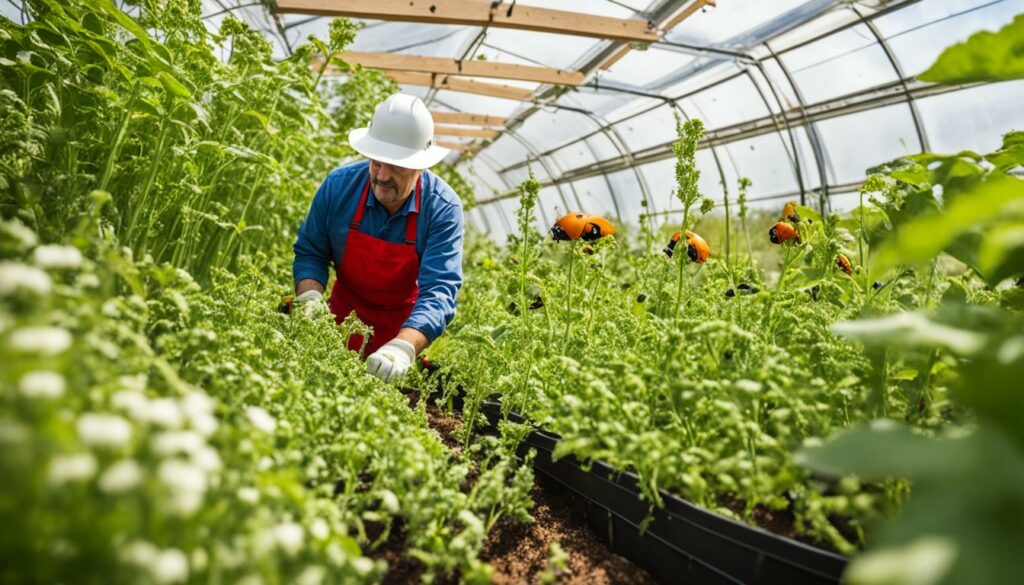
Birds help control pests. By attracting them, farmers can avoid harmful toxins. This benefits both the farm and the environment. It matches the natural balance.
A study found that potato fields using organic methods had more helpful species. This made them better at pest control than conventional fields.
Organic farms use a mix of predators for pest control. A USDA study found they were better at it than in non-organic farms. This helps keep the farm healthy.
| Aspect | Organic Farming | Conventional Farming |
|---|---|---|
| Natural Enemy Abundance | High | Low |
| Biodiversity | Enhanced | Reduced |
| Pest Control | Effective | Less effective |
| Use of Synthetic Pesticides | Minimal | Frequent |
Using predators is key to organic success. It’s about working with nature. This way, farms stay healthy without hurting the environment. It’s a win for everyone.
Organic farming focuses on using water wisely and conserving it in natural ways. This helps keep our water clean and supports diverse life in water. It also protects the health of our whole ecosystem.
Organic farmers work hard to keep our waterways clean. They use methods that cut down on nitrogen leaching by 40-64%. This is much better for the environment than traditional farming.
The EU’s Water Framework Directive (2000/60/EC) highlights the need to protect different types of water. Organic farming helps meet these goals. It also helps reduce issues like floods and droughts by up to 30%.
In organic farming, recharging groundwater is key. By managing soils well, they improve water flow underground. This keeps our water tables steady and supports life in the water.
The EU aims to clean up our water and reduce pollution by 2030. Organic farming is a big part of this plan. It shows how farming in natural ways helps our environment.
Organic farms are great for wildlife, with 34% more species and 50% more wildlife. This is why choosing organic is not only good for saving water but also for protecting animals that live in and around water.

Using livestock in organic farming is key for biodiversity. It helps create lively agro-pastoral areas. Organic animal care boosts both above-ground and below-ground life a lot. From 1997 to 2007 in the UK, organic and converting farms grew from 828 to 4639. This shows how widespread integrated livestock systems are becoming.
Organic farms stand out from non-organic ones. They are smaller by 32% but have 50% more edge space for wildlife. This extra space supports different species. Also, they have 71% more hedges, which means more homes for many animals.
Organic farms use more land for grass. This helps provide large areas for animals to graze. Livestock not only benefits from this but also improves the soil. This is important for both plants and wildlife, which boosts overall diversity.
Many organic farmers join special farming schemes for the environment. 64% of them are in such schemes, compared to only 43% of non-organic farmers. These schemes help keep farming biodiverse.
Also, organic practices reduce phosphorus in water, which is good for biodiversity. This shows how organic ways help balance nature’s needs.
Organic farming’s mix of animals and crops truly supports biodiversity. Every part of the system, from grazing to growing specific plants, is important. Together, they create a strong, diverse ecosystem. Organic farms are vital for protecting and growing wildlife. This shows how integrating livestock into farming is crucial for our planet.
Organic farming is key in creating a friendly space for pollinators. This not only helps farming but also the bees and other pollinators. Around seventy-five percent of our food needs pollinators to grow, especially honey bees. They alone help create about $12.4 billion of crops in the U.S every year.
Organic farms are great for bees and butterflies. They use methods that are friendly to these insects. For example, they don’t use harmful chemicals. Since 2006, a lot of bee hives have been lost due to these chemicals in normal farms. Organic farms, however, do not allow them, making it a safe place for bees and butterflies.
Organic farming pays attention to having many different types of plants. They plant a lot of flowers to attract many pollinators. This is especially good for saving butterflies. Organic farms have been shown to have 50% more types of pollinators than non-organic ones. This effort has been backed by the White House, showing that it’s important for both the economy and the environment.
Organic farming is vital for keeping a good relationship between plants and pollinators. This is clear from the high crop values that depend on honey bees. The focus on varied plants and friendly farming methods helps keep our environment and farms healthy.
It’s vital to keep the soil healthy in farming without chemicals. We do this by stopping soil from washing or blowing away. For example, we plant crops that have deep roots to hold the soil. This helps keep a variety of plants, insects, and animals around. So, taking care of the soil this way helps the whole farm to have more life.
One way to stop soil from eroding is using windbreaks and shelterbelts. These are rows of trees or bushes that block the wind. By doing this, they protect the soil and keep it from moving. They also make good homes for animals. This builds up life on the farm.
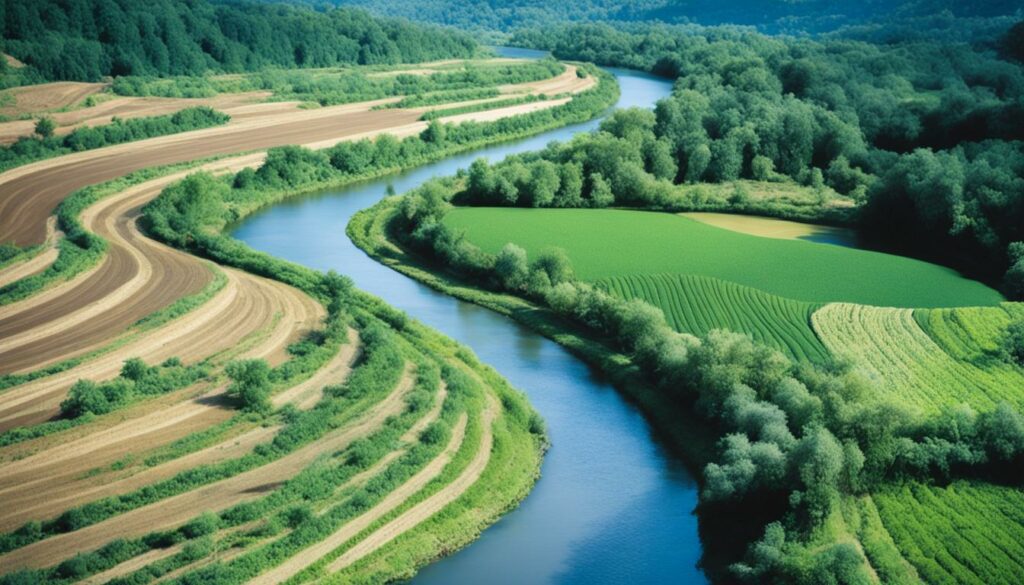
Using plants with deep roots is a big help against erosion. Plants like clover and alfalfa keep the soil in place. This means the soil doesn’t wash or blow away easily. Also, these plants add nutrients to the soil. This makes it better for growing food. We call this keeping the soil fertile. It helps the farm stay healthy and full of different plants and animals.
| Organic Practice | Impact on Soil | Impact on Biodiversity |
|---|---|---|
| Windbreaks/Shelterbelts | Reduces wind erosion | Provides habitat for wildlife |
| Deep-Rooted Cover Crops | Reduces soil erosion | Enhances soil biodiversity |
Research shows that farms with windbreaks and cover crops have more types of plants and animals. They also help the environment by reducing harmful chemicals in the water. This is good for the sea and the fish. By using these special ways to keep the soil in place, farmers help make their farms a better place for nature.
These special ways of protecting the soil help wildlife to thrive. They also make sure the farm can keep growing food. This is very important for the future of farming.
Organic farming is well-known for its ability to save money in farming. This is done by using more things from nature, which helps cut back on buying expensive chemicals. Organic farmers use the power of nature to grow food and this saves a lot of money over time.
Comparing organic and conventional farming shows organic is way better for the earth. Organic farms have been found to be 8.5 and 5.9 times better for the environment when growing winter wheat and spelt. They have less bad gases and save energy better. This all means they do more for less.
Biodiversity is a big plus on organic farms, not just because it saves money. It means more bugs that eat the bad bugs, meaning less need for pricey pesticides. Also, more animals like bees that help plants make fruit and seeds. This all helps make food better and keeps the land healthy for the future.
In Europe, farmers get paid to grow food organically and help nature. These payments support the idea that nature on farms is worth money. The goal is to keep nature strong by paying those who take care of it.
Many think organic farms can’t make as much money as other farms but that’s not true. Organic products often sell for more money. Plus, once a farm goes organic, it can make almost as much food. This shows you can make money, be kind to nature, and make good food all at once.
Below is a table showing how organic and conventional farming differ:
| Aspect | Conventional Farming | Organic Farming |
|---|---|---|
| Dependency on External Inputs | High (chemical fertilisers, pesticides) | Low (natural fertilisers, biological pest control) |
| Production Costs | High (ongoing input costs) | Lower (after initial transition period) |
| Environmental Impact | Negative (soil degradation, high emissions) | Positive (enhanced soil quality, lower emissions) |
| Yield (after initial transition) | 100% | 95% |
| Market Prices | Standard | Premium |
Organic farming leads to good economic and ecological outcomes. It helps keep farming strong and nature healthy. By focusing on the earth and using money wisely, organic farming sets a great example. Here, taking care of nature means a better future for everyone.
Studies show that organic farming is great for nature. It boosts the number of different species by about 30%. This is better than what happens in conventional farming. Over the last 30 years, organic farming keeps helping biodiversity a lot. It works especially well in busy farming areas.
A close look at the results points out some interesting things. The effect organic farming has changes depending on what is being grown. And what species it helps differs too. These findings show how organic farming is good for many types of land and organisms. Even though some studies come from only a few places, they all agree. Organic farms are best for nature in places with a lot of farming going on.
There are clear examples of how organic farming helps save species. For example, a project called “Farming for species diversity” has done a lot to protect wild plants and animals. It gives farmers special points for protecting nature. This makes their organic products more valuable.
The initiative in Mecklenburg-Western Pomerania, involving WWF Germany, the federation of organic farming Biopark, and retailer EDEKA, exemplifies the effective collaboration towards biodiversity conservation.
Researchers looked at 94 studies from 2005 to 2011 and 27 older ones. These studies all support organic farming. They show it is better for the planet than usual farming.
Some detailed research has focused on specific organic farms. These farms stand out for the good they do for nature. The work done there is a strong reason to support more organic farming.
Organic farms have more termites than non-organic ones. This is true no matter how much is put into the farm. In one study, they checked over 60,000 termites from nine different types. This shows how organic farming and nature depend on each other.
It’s important to keep learning from organic farming’s success. This can help make farming around the world more sustainable.
Organic farming is praised for its green practices but faces hurdles. Yet, there’s a lot of room for growth and new ideas in this field. Solving organic farming’s challenges will help us make the most out of it.
Organic farmers need to meet tough rules and beat others in the market. They stick to these rules to keep organic farming true to its values. In 2018, the EU gave over 1.8 billion € to help farmers switch to organic. This money comes from the 3% of the CAP budget set aside for helping farmers. It shows how important it is to overcome challenges and support organic farming’s growth.
Organic agriculture is always finding new ways to grow. It helps more plants and animals thrive, as seen in Europe’s 30% boost in life variety. Organic fields have more plant species and life in them than non-organic ones. This is good news for soil health and the living things that depend on it.
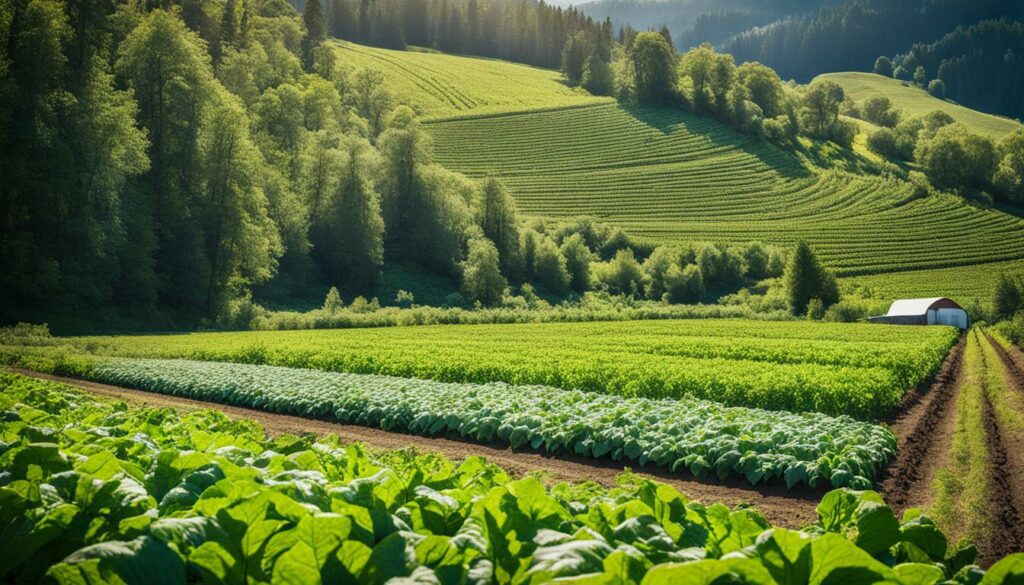
Managing grass and growing things organically have big benefits. Fields for crops show more life when grown organically. This is especially true for birds that eat insects. Using new ideas in eco-farming is key to a green future.
Organic farming is growing fast around the world. More organic fields, more organic food, and more organic farmers come each year.
| Region | Support for Organic Farming (€) | Land Area Represented (%) | Biodiversity Impact (%) |
|---|---|---|---|
| Europe | 1.8 billion € | 8% | 30% |
| Arable Farms | Varies by Country | N/A | 20-95% more plant species |
| Organic Horticulture | Specific Regional Support | N/A | Greater insectivorous bird species |
Looking ahead, the future is promising for sustainable farming. By tackling challenges and encouraging growth through new ideas, we can make a big difference for the planet. A strong focus on biodiversity and soil health will lead to a more successful and resilient farm industry.
Organic farming is a powerful friend in helping nature thrive. Since 2008, the number of farm birds in Slovenia has dropped. This is mainly due to intense farming. This shows we need to farm more sustainably.
Research proves that organic farming boosts the quality of our soil. It also lowers harmful chemical leaks and emissions. Compared to traditional farming, organic farming uses energy and land better. It results in more plant and animal variety. Yet, the benefits can vary.
A deep review found that organic farming is usually better for nature. But in some cases, like with soil animals, traditional farming might do a bit better. Still, overall, organic methods are the best choice for the environment.
Organic farming does superbly in growing winter wheat and spelt. It does 8.5 times and 5.9 times better, respectively. This is important because only 17% of the EU’s nature is in good shape. Organic farming helps keep our plants and animals diverse. Good care is key to this success.
My research shows organic farming is great for nature, but its effects can differ. It’s crucial to study more to fully understand. To protect biodiversity, we must keep following nature-focused farming. This way, we make sure our farms are both productive and kind to our planet.
Organic farming helps biodiversity in many ways. It uses practices like rotating crops and planting local plants. It also adds compost and deep-rooted plants.This helps different soil creatures and creates homes for local animals.
Compared to traditional methods, organic farming is more beneficial. It makes the soil healthier and the environment balanced. It also boosts biodiversity.Instead of relying on one crop and harsh chemicals, organic farms use friendlier methods. This makes farming more able to face challenges.
Organic farms keep pests in check without chemicals. They let natural enemies like birds and bats help. Planting different crops draws good insects that eat the pests.This way, they use fewer harmful chemicals and keep the farm’s natural balance.
Having animals on the farm is good for biodiversity. They help the surface and soil become richer. By using animal waste for crops, the farm stays healthy.This method helps the farm use nutrients better and have healthier soil.
Organic farms care for water by reducing chemical runoff. They also improve the water table using special plants and by setting aside areas. This protects water life.It keeps rivers and lakes diverse and healthy.
Organic farming is good for the wallet. It cuts costs on things like fertilisers and pest control. Healthy soil and natural ecosystems boost crop growth and save money.This helps the farm make more profit.
Soil health is key to lots of life on the farm. Things like compost and cover crops make the soil better. This welcomes a mix of tiny creatures that help the farm grow.This richness is vital for a thriving and productive farm.
Organic farmers help pollinators by keeping wild areas safe, planting flowers, and avoiding poisons. They help bees and butterflies live well.This protects their crops and supports life on the farm.
Organic farmers work hard to keep the farm natural. They need to meet strict rules and fight off competition. They also have to deal with pests safely.But, these challenges push them to get better at caring for the land.
Windbreaks and shelterbelts stop the soil from blowing away. They lower the wind’s force, saving the soil. This keeps the land healthy and lets many kinds of life thrive.This makes the farm a more complex and living place.